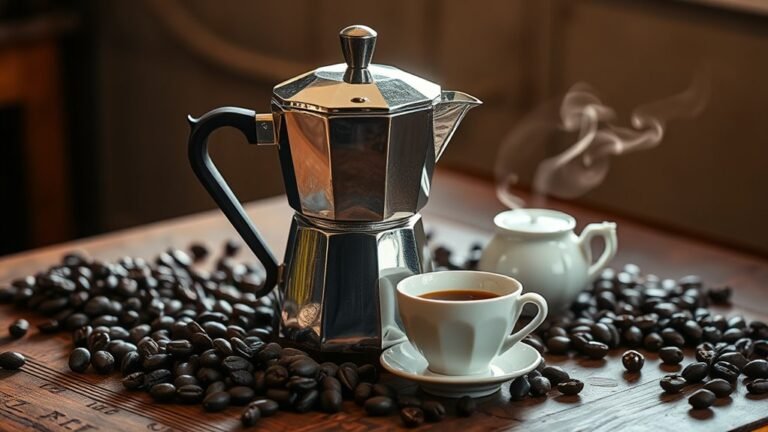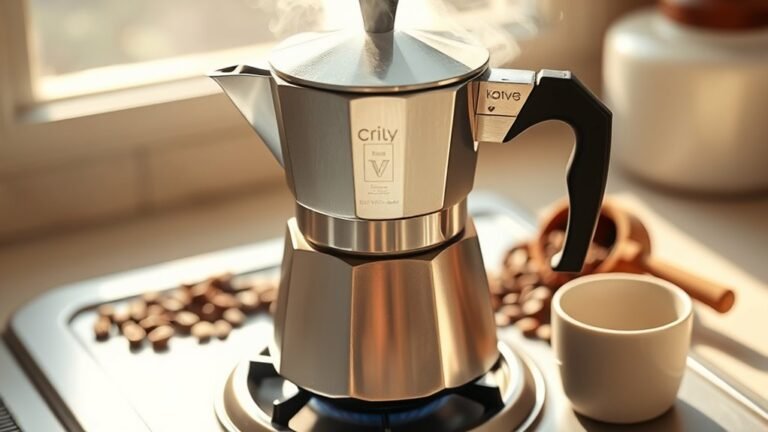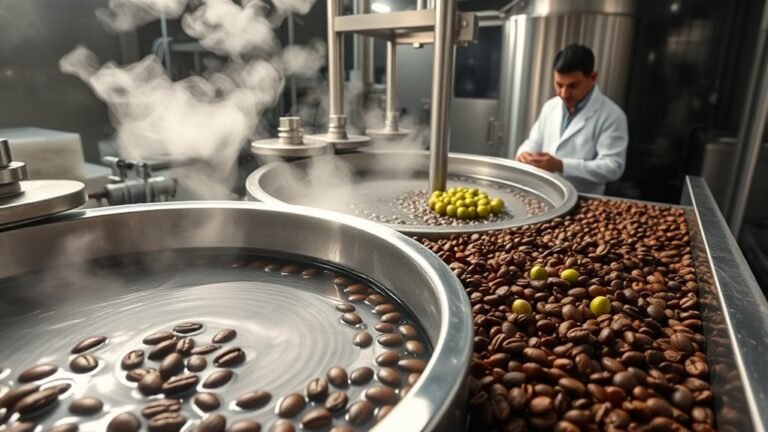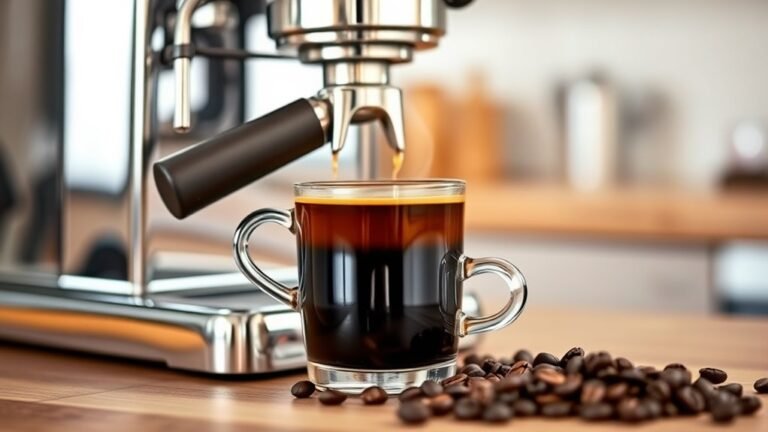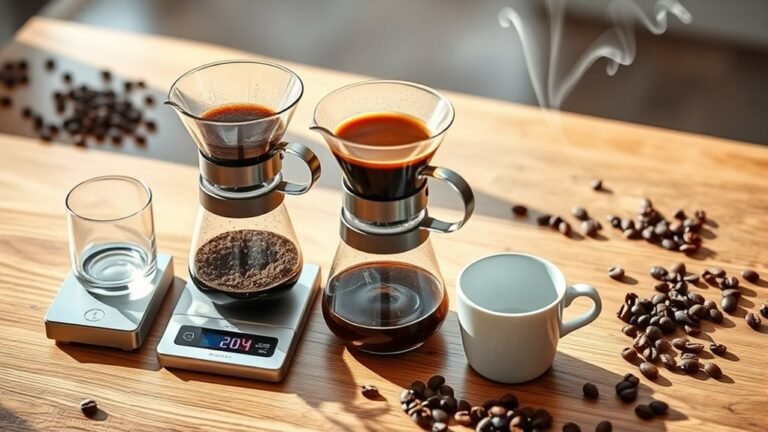Japanese Iced Coffee vs. Cold Brew: What’s the Difference?
If you want a bright, crisp cup, Japanese iced coffee brews hot water directly over ice, locking in vibrant flavors quickly. Cold brew, on the other hand, steeps coffee grounds slowly in cold water for 12-24 hours, resulting in a smooth, mellow, and less acidic drink. Each method uses different equipment and grind sizes to balance extraction. Curious about what makes these methods unique and how to perfect your brew? There’s a rich story behind both.
The Origin and History of Japanese Iced Coffee
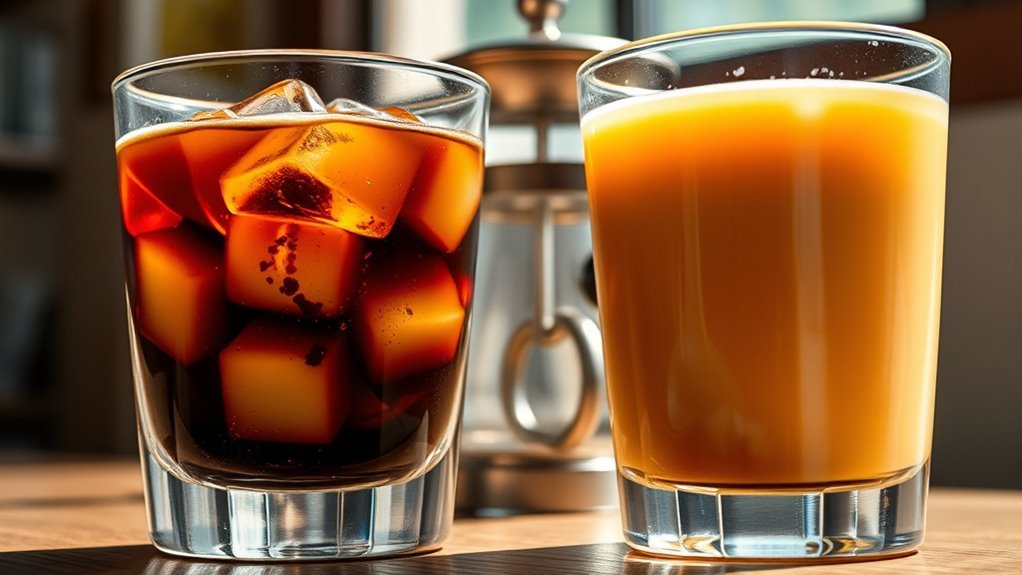
Although Japanese iced coffee might seem like a modern trend, its roots trace back to traditional Japanese tea culture combined with innovative brewing techniques. You’ll find that its Japanese origins emphasize precision and respect for flavor balance. Unlike just chilling brewed coffee, this method involves brewing hot coffee directly over ice, instantly locking in the vibrant aromas and bright acidity. This approach reflects Japan’s dedication to craftsmanship, where every step is intentional and refined. When you try Japanese iced coffee, you’re experiencing a unique blend of heritage and innovation—brewing techniques that honor ancient customs while embracing modern desires for freshness and clarity. It’s a liberating way to enjoy coffee, offering you a crisp, lively taste that stands apart from other iced varieties.
How Cold Brew Coffee Is Made
When you want a smooth, mellow coffee experience, cold brew is made by steeping coarsely ground coffee beans in cold water for an extended period, usually 12 to 24 hours. This slow extraction highlights subtle flavors without the bitterness or acidity found in hot brewing techniques. To get it right, you’ll want to pay close attention to coffee ratios—typically, a 1:4 to 1:8 ratio of coffee to water is ideal, depending on your desired strength. You simply combine your grounds and cold water, then let time do the work. After steeping, you strain the mixture to separate the grounds, leaving a concentrated, velvety brew. This method gives you freedom to prepare coffee in advance and savor a rejuvenating cup anytime.
Brewing Time and Temperature Differences
Since brewing time and temperature are essential factors that shape your coffee’s final flavor, it’s important to understand how Japanese iced coffee and cold brew differ in these aspects. Japanese iced coffee uses hot water poured directly over grounds, extracting flavors quickly—usually within 2 to 3 minutes. This rapid brewing method captures bright, vibrant notes by maximizing flavor extraction at higher temperatures. On the other hand, cold brew relies on a slow, long extraction process, steeping grounds in cold water for 12 to 24 hours. The low temperature slows extraction, producing a smooth, mellow coffee with less acidity. Knowing these brewing methods empowers you to choose how you want your coffee experience—whether you crave the lively intensity of Japanese iced coffee or the laid-back richness of cold brew.
Flavor Profiles: Brightness vs. Smoothness
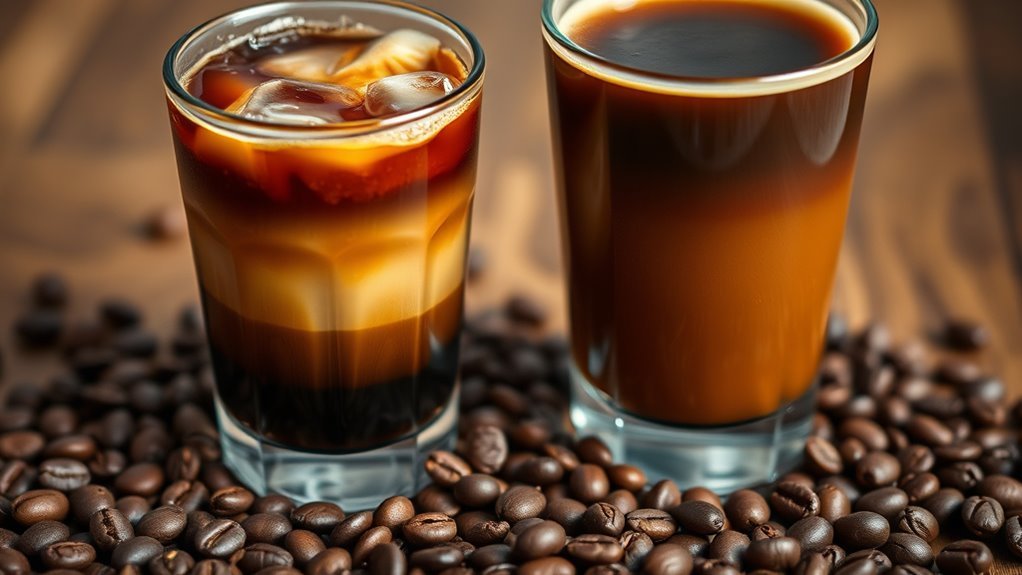
Anyone who’s tasted both Japanese iced coffee and cold brew knows they offer distinctly different flavor experiences. With Japanese iced coffee, you get a vibrant brightness contrast that wakes up your palate, thanks to the quick brewing with hot water directly over ice. This method preserves the coffee’s lively acidity and crisp notes, giving you a rejuvenating, zesty cup. Cold brew, on the other hand, leans into smoothness and richness, as the slow, cold extraction process mellows the flavors and reduces bitterness. It’s silky, sweet, and velvety—perfect if you want a mellow, indulgent experience. So, whether you crave that bright, sparkling zing or a smooth, rich embrace, your choice defines your coffee’s personality and the freedom to enjoy it your way.
Equipment Needed for Each Method
When brewing Japanese iced coffee or cold brew, the equipment you use can make all the difference. You’ll want to contemplate the brewing devices, filtration tools, and how you’ll control the temperature for each method. Understanding these essentials helps you get the perfect cup every time.
Brewing Devices Required
Both Japanese iced coffee and cold brew require specific brewing devices that shape their unique flavors and preparation styles. When you’re choosing your coffee equipment, the right brewing devices matter because they influence extraction time and temperature, which ultimately impact taste.
For Japanese iced coffee, you’ll typically need:
- A pour-over dripper designed for quick brewing
- A coffee server or carafe to catch the brew
- A vessel for ice to immediately chill the coffee
Cold brew, on the other hand, calls for devices that support long steeping times, such as:
- A large mason jar or dedicated cold brew maker
- A coarse mesh or nylon filter
- A container to store the brew as it infuses
Choosing your brewing devices wisely lets you embrace freedom in crafting coffee that suits your style.
Filtration Tools Used
Although the brewing devices set the stage, the filtration tools you use play an essential role in defining the clarity and texture of your coffee. Each method’s filtration methods differ, impacting your coffee’s mouthfeel and purity. Japanese iced coffee typically uses paper filters that trap fine grounds, resulting in a bright, crisp cup. Cold brew, on the other hand, often relies on mesh or metal filters, which allow more oils and sediment through, lending a fuller body.
| Method | Filtration Tool |
|---|---|
| Japanese Iced Coffee | Paper filters (V60, Chemex) |
| Cold Brew | Fine mesh sieve or metal filter |
| Japanese Iced Coffee | Single-use paper filters |
| Cold Brew | Reusable cloth filters |
Choosing your filtration tools carefully complements your brewing devices, giving you freedom to craft your perfect cup.
Temperature Control Gear
Mastering temperature control is essential to revealing the best flavors in your coffee, and each brewing method demands its own set of precise tools. For Japanese iced coffee, rapid temperature regulation is vital—brewing hot coffee directly onto ice requires you to monitor water temperature carefully. Cold brew, on the other hand, relies on consistent cool temperatures over an extended period, demanding different gear.
Here’s what you’ll need:
- Brewing thermometers to measure hot water for Japanese iced coffee
- Insulated containers or coolers to maintain chill during cold brew extraction
- Timers to keep track of steeping duration alongside temperature changes
With the right temperature control gear, you can access the full spectrum of your coffee’s flavor, whether you’re in the mood for bright and crisp or smooth and mellow.
Impact on Caffeine Content
When you brew Japanese iced coffee, the hot water and short extraction time pull caffeine out quickly, giving you a strong kick. Cold brew, on the other hand, uses cold water and a long steeping period, which extracts caffeine differently and often results in a smoother, sometimes higher caffeine content. Understanding how temperature and time affect caffeine helps you choose the brew that fits your energy needs.
Extraction Time Effects
Because extraction time directly influences how much caffeine ends up in your cup, understanding its effects is essential when comparing Japanese iced coffee and cold brew. The extraction duration is a key brewing variable that shapes caffeine levels. Japanese iced coffee uses a short, hot brew—typically just a few minutes—extracting caffeine quickly but efficiently. Cold brew, on the other hand, relies on a long, slow extraction, often 12 to 24 hours, allowing caffeine to seep out gradually.
Here’s what you should know about extraction time effects:
- Short extraction duration yields a brighter, more acidic cup with balanced caffeine.
- Long extraction duration pulls more caffeine but also more bitters and solids.
- Brewing variables like grind size and agitation influence how caffeine extraction unfolds over time.
Knowing this helps you choose a brew that fits your caffeine freedom perfectly.
Temperature’s Role in Caffeine
Although extraction time plays an essential role, temperature greatly impacts how caffeine is drawn from coffee grounds, shaping the final brew’s strength and flavor. When you brew hot, like with Japanese iced coffee, higher temperatures accelerate caffeine extraction, resulting in a brighter, more robust cup with higher caffeine levels in a shorter time. On the other hand, cold brew relies on lower temperatures to slowly coax caffeine and flavors out over hours, producing smoother, less acidic coffee with slightly different caffeine content. Understanding these temperature effects lets you choose a method that fits your mood—whether you want a quick, vibrant caffeine kick or a mellow, drawn-out experience. So, temperature doesn’t just influence taste; it fundamentally alters caffeine levels, letting you savor coffee your way.
How Grind Size Affects Extraction
Since grind size directly influences how water interacts with coffee grounds, it plays an essential role in extraction for both Japanese iced coffee and cold brew. When you adjust grind size, you control extraction efficiency, determining how much flavor and strength you get.
For Japanese iced coffee, a medium grind works best because the quick hot water contact demands faster extraction. Cold brew, on the other hand, benefits from a coarser grind, allowing slow, steady flavor release over time.
Keep these points in mind:
- Finer grinds increase surface area, speeding up extraction
- Coarser grinds slow extraction, preventing over-extraction
- Matching grind size to brewing time optimizes flavor balance
Serving Suggestions and Pairings
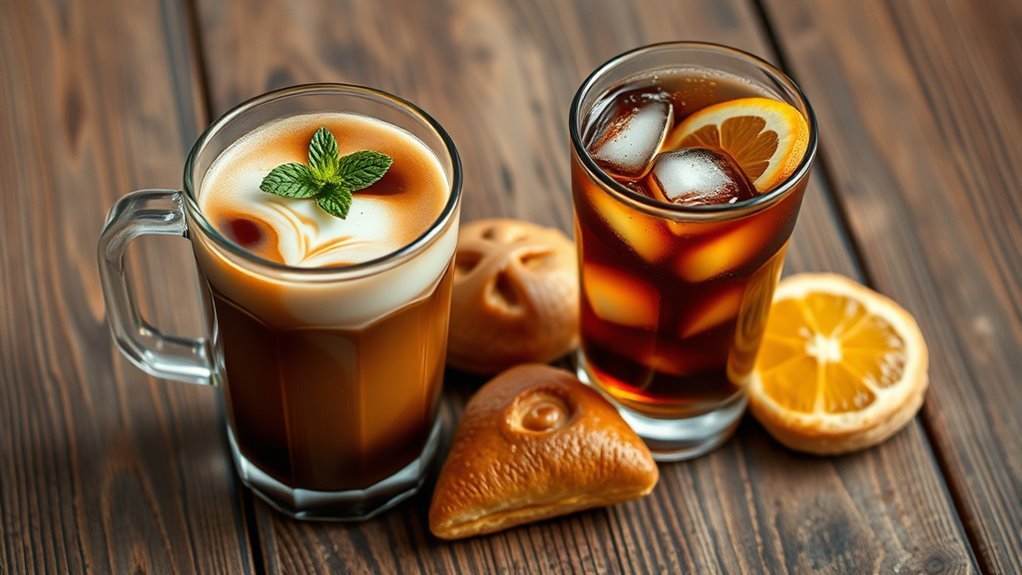
When you’re ready to enjoy your Japanese iced coffee or cold brew, knowing the best ways to serve and pair them can elevate the experience. Japanese iced coffee is best served immediately over fresh ice to secure its bright, vibrant flavors at a crisp serving temperature. It pairs beautifully with light, citrusy desserts or fresh fruit, enhancing its lively notes. Cold brew, on the other hand, shines when served chilled but not overly cold, preserving its smooth, mellow profile. Its rich, chocolatey undertones complement hearty food pairings like nutty granola, chocolate pastries, or even savory breakfast dishes. By paying attention to serving temperature and thoughtful food pairings, you’ll reveal the full potential of each brew, making every sip a moment of freedom and flavor exploration.
Common Mistakes When Brewing
When brewing Japanese iced coffee or cold brew, getting your water temperature just right is essential—too hot or too cold can throw off the flavor. You also need to pay attention to your coffee grind size; too fine or too coarse can affect extraction and taste. Finally, timing matters: brewing too long or too short will change the strength and balance of your cup.
Water Temperature Errors
Anyone diving into brewing Japanese iced coffee or cold brew quickly learns that water temperature plays a critical role in the outcome. Getting this wrong can throw off the delicate balance of flavors and ruin your brew. For Japanese iced coffee, you want water just off the boil—around 195-205°F—to extract vibrant flavors quickly. Cold brew, on the other hand, uses room temperature or cold water for a slow, smooth extraction.
Common water temperature errors include:
- Using boiling water for cold brew, which extracts unwanted bitterness
- Brewing Japanese iced coffee with water that’s too cool, leading to weak flavor
- Ignoring brewing precision, causing inconsistent results
Mastering water temperature means embracing control, freeing you to craft the perfect cup every time.
Coffee Grind Size
Although grind size might seem like a small detail, it greatly influences the flavor and extraction of both Japanese iced coffee and cold brew. If your grind isn’t consistent, you risk uneven extraction—some grounds over-extracting, others under-extracting—leading to bitterness or weak flavors. For Japanese iced coffee, a medium grind works best to balance quick hot water contact and fast cooling, ensuring ideal extraction efficiency. Cold brew, on the other hand, demands a coarse grind to allow slow, steady extraction over hours without becoming overly bitter or muddy. Getting your grind consistency right lets you access the full potential of your beans, giving you freedom to craft the perfect cup every time, whether you crave bright, crisp notes or smooth, mellow richness.
Brewing Time Mistakes
Getting your grind size right sets a solid foundation, but timing your brew correctly is just as important to avoid common pitfalls. When brewing Japanese iced coffee or cold brew, misjudging brewing time can lead to under-extracted sourness or over-extracted bitterness. Temperature mistakes also play an essential role; too hot or too cold water affects flavor balance. To steer clear of these issues, keep in mind:
- For Japanese iced coffee, brew quickly (about 2-3 minutes) with near-boiling water for bright, crisp flavors.
- Cold brew demands patience—steep grounds for 12 to 24 hours in cold water for smooth, mellow notes.
- Avoid rushing or extending brew times beyond these ranges, or you risk muddy or weak coffee.
Mastering brewing time and temperature lets you enjoy freedom in crafting your perfect iced coffee.
Which Method Suits Different Coffee Preferences
When you’re deciding between Japanese iced coffee and cold brew, your taste preferences play a key role in which method will satisfy your palate. Japanese iced coffee highlights bright, vibrant flavors thanks to quick brewing techniques, while cold brew offers a smoother, less acidic profile with rich sweetness. Here’s a simple guide to match your flavor preferences with the right method:
| Flavor Preferences | Japanese Iced Coffee | Cold Brew |
|---|---|---|
| Bright & Crisp | Yes | No |
| Smooth & Sweet | No | Yes |
| Quick Brew Time | Yes (minutes) | No (hours) |
| Bold & Complex | Moderate | High |
Choose based on your desired flavor intensity and time freedom.
Frequently Asked Questions
Can Japanese Iced Coffee Be Made With Decaf Beans?
You can definitely make Japanese iced coffee with decaf beans, and you’ll enjoy the decaf advantages like less caffeine without sacrificing flavor. The brewing technique involves brewing hot coffee directly onto ice, which locks in aromatic oils and brightness. Using decaf beans works just as well here, so you don’t have to miss out on that fresh, vibrant cup. It’s a perfect way to savor coffee freedom without caffeine jitters.
Is One Method More Eco-Friendly Than the Other?
Think of sustainability practices as the roots of a tree—deeply affecting the environmental impact you leave behind. You’ll find that cold brew often uses more coffee grounds and longer brewing times, which can mean higher water and energy consumption. Japanese iced coffee, brewed quickly, tends to use fewer resources. So, if you’re aiming to minimize your footprint while enjoying your freedom in flavor, Japanese iced coffee might be the greener choice.
How Long Does Each Coffee Stay Fresh After Brewing?
You’ll find that the freshness duration varies between coffee types. Japanese iced coffee is best enjoyed within 12 hours for peak flavor, so keep it chilled and sealed tightly. Cold brew, thanks to its low acidity, stays fresh up to 7 days refrigerated. To maintain taste, store either in airtight containers away from light. These storage tips help you savor your brew longer, giving you freedom to enjoy great coffee on your schedule.
Can You Use Flavored Syrups With Both Methods?
Imagine your coffee as a canvas, waiting for colors to bring it alive. You can absolutely use flavored syrups with both methods, but syrup compatibility depends on the flavor profile. Japanese iced coffee’s bright acidity pairs well with fruity or floral syrups, while cold brew’s smooth, mellow notes blend beautifully with richer, caramel or vanilla flavors. So, go ahead and experiment—you’ve got the freedom to craft your perfect cup every time.
Are There Health Benefits Unique to Either Brewing Style?
When you explore different brewing methods, you’ll notice some unique health benefits. Japanese iced coffee tends to retain more antioxidants because it brews quickly with hot water, preserving compounds that boost your immune system. Cold brew, on the other hand, is less acidic, which might be easier on your stomach and better if you’re sensitive to acidity. So, depending on your health goals, each method offers distinct perks you can enjoy freely.

